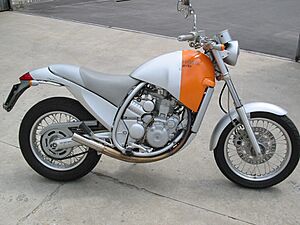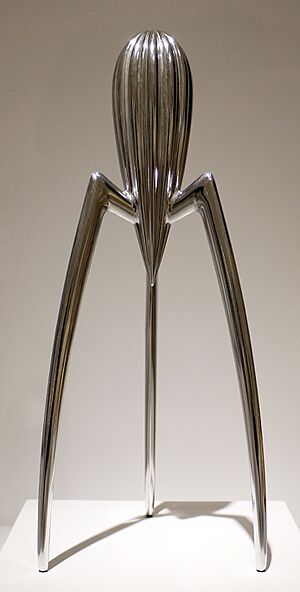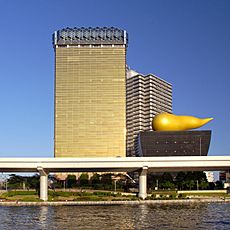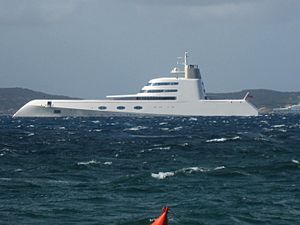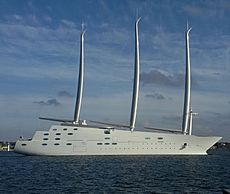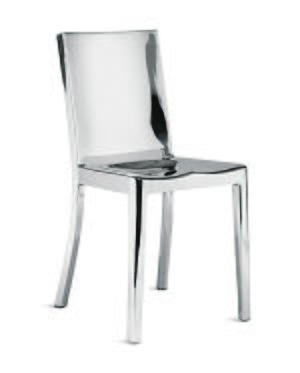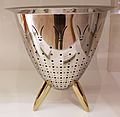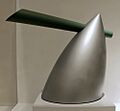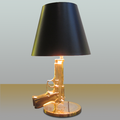Philippe Starck facts for kids
Quick facts for kids
Philippe Starck
|
|
|---|---|
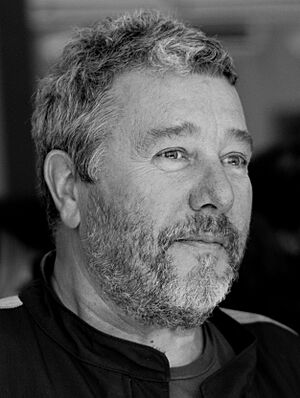
Starck in 2011
|
|
| Born | 18 January 1949 Paris, France
|
| Nationality | French |
| Alma mater | École Nissim de Camondo |
| Occupation | Architect |
| Children | Ara Starck, Oa Starck, K Starck, Lago Starck |
| Parent(s) | André Starck, Jacqueline Starck |
| Awards | Ordre des Arts et des Lettres Legion of Honour |
| Buildings | Asahi Beer Hall |
Philippe Starck (born January 18, 1949) is a famous French designer and architect. He is known for creating many different things. These include buildings, furniture, household items, boats, and other vehicles. His most popular designs were made in the 1980s and 1990s. Starck is seen as a leader in "democratic design." This means he tries to make great products using few materials. His goal is to make life better for the people who use his designs.
Contents
About Philippe Starck
Starck was born in Paris, France, on January 18, 1949. His father, André Starck, was an aeronautics engineer. Philippe says his father inspired him a lot. He learned from his father that inventing new things was important. Starck's family came from the Alsace region before his grandfather moved to Paris. Philippe studied design at the École Nissim de Camondo in Paris.
Starck's Design Career
Philippe Starck started his first design company, Starck Product, while working for Adidas. He later changed its name to Ubik. Through this company, he worked with many manufacturers across Europe. These included famous companies like Driade, Alessi, and Kartell in Italy. He also worked with Vitra in Switzerland and Disform in Spain.
In 1983, the French President François Mitterrand asked Starck to redesign his private apartments. These were in the Élysée Palace. The next year, Starck designed the famous Café Costes. One of his most well-known designs is the Juicy Salif lemon squeezer for Alessi, made in 1987. Another popular item is the Louis Ghost Chair for Kartell (2000). Over two million of these chairs have been sold.
After these successes, Starck designed even more things. His work included furniture, decorations, and even street furniture. He also designed industrial items like wind turbines and photo booths. His designs covered bathroom fittings, kitchens, and lighting. He even designed everyday items like staplers, tableware, clothing, and toys. Starck also created vehicles for land, sea, and air.
Starck's Architecture Projects
Starck began designing buildings in Japan in 1989. His designs were very different from traditional Japanese buildings. His first building, Nani Nani, in Tokyo, looked like a unique, organic shed. A year later, he designed the Asahi Beer Hall in Tokyo. This building has a large golden flame on top. In 1992, he designed the Le Baron Vert office complex in Osaka.
In France, Starck helped design an extension for the École Nationale Supérieure des Arts Décoratifs (ENSAD) in Paris (1998). In 1991, he designed one of the special pavilions for the new Groninger Museum in the Netherlands.
In October 2024, LA Almazara opened in Ronda, Andalusia, Spain. Philippe Starck designed this entire olive oil mill. It was the first olive oil mill designed by a world-famous designer. It is a unique place with an oil press, a museum, and a restaurant. The Times magazine even listed it as one of the World's Greatest Places of 2025.
Since the late 1980s, Starck has designed many hotels around the world. These include the Royalton Hotel (1988) and the lobby of the Paramount Hotel (1990) in New York City. He also designed the Delano in Miami and the Hudson Hotel. Other hotels include the Mondrian Hotel in West Hollywood and the Sanderson in London. More recently, he worked on Le Meurice renovations in 2016 and the Royal Monceau (2010) in Paris. He also designed the Hotel Brach (2018) and the Hotel 9Confidentiel (2018) in Paris. In France, he designed La Co(o)rniche and Ha(a)itza hotels in Arcachon. In 2019, Starck created the Lily of the Valley Hotel on the French Riviera. In 2020, he opened La Réserve Eden au Lac Zurich.
In 2022, Philippe Starck became the artistic director of the TOO Hotel in Paris. This hotel is at the top of one of Jean Nouvel's DUO Towers. That same year, he worked with architect Jean Nouvel again. They designed the Rosewood Sao Paulo hotel. Most of the materials used were from Brazil and inspired by Brazilian culture. Also in 2022, Starck helped open the MOB House hotel and restaurant in Saint-Ouen. This hotel was designed for longer stays.
In 2023, Philippe Starck became the artistic director of Mondrian Bordeaux les Carmes. This hotel in Bordeaux is inspired by Japanese culture. It also features typical Bordeaux architecture.
Starck has designed several restaurants. Early ones include the Café Costes (1984) in Paris and Manin (1985) in Tokyo. More recently, he designed restaurants with the Alajmo brothers. These include Caffe Stern (2014) in Paris and Amo (2016) in Venice. He also designed Gran Caffe Quadri (2018) and Amor (2019) in Milan. He designed La Réserve à la Plage in Saint-Tropez and The Avenue at Saks in New York in 2019.
The Alhondiga is a large cultural and leisure center in Bilbao, Spain. Starck designed this 43,000 square-meter venue, which opened in 2010. Starck also designed affordable, pre-made P.A.T.H. houses.
The Hilton Worldwide company asked Starck to create a new hotel in Metz, France. This hotel, Maison Heler, is a unique building. It has a traditional Alsatian house on top, symbolizing the region. It opened in 2025.
Starck's Yacht Designs
Starck designed the Wedge Too, a 65-meter (213 ft) superyacht. It was built by Feadship and launched in 2002.
In 2004, a Russian businessman named Andrey Melnichenko asked Starck to design the Motor Yacht A. Later, in 2012, Starck designed the A (sailing yacht), which is one of the world's largest sailing yachts.
Starck also designed the new luxury marina in the Port Adriano harbor in Spain. It opened in April 2012.
In 2008, Starck designed the 78-meter (256 ft) superyacht Venus for Steve Jobs. The yacht was launched in October 2012, about a year after Jobs passed away. It was built in the Netherlands.
Starck's Furniture Designs
In 2010, Starck created the Zartan chair for Magis. This chair is made entirely from natural materials like bamboo, linen, and hemp fiber. It is a non-toxic and biodegradable choice instead of plastic.
In 2012, Starck released the Broom chair for Emeco. This chair is made from recycled materials collected from wood and plastic factories. It helps reduce waste.
Starck released Cassina Croque la pomme in 2019. This is a furniture collection for Cassina. It is made from a vegan fabric that uses apple leather. In the same year, he created Smart Wood for Kartell. This collection of seats uses very little material. It uses a special molding technique with wood leftovers.
For Salone del Mobile 2022, Dior Maison asked Starck to redesign their classic Médallion seat.
Starck's Technology Innovations
In 1996, Starck worked with Alain Mikli to create Starck Eyes eyewear. In 2013, Luxottica bought Starck Eyes and renamed it Starck Biotech Paris in 2019. Starck Biotech Paris designs eyewear inspired by the human body. It combines design with how the body works.
Starck helped design the Xiaomi Mi MIX smartphone. This phone is special because it has a large "whole surface screen."
In 2016, Starck developed a GPS-tracking wristband called DIAL. This device helps people in danger share their exact location with rescue services. It can be used from the sea or the beach.
In 2018, Starck worked with Axiom Space. He designed the inside of the International Space Station's living module. It is a comfortable and luxurious space for astronauts. It has soft walls, big windows, and technology to stay connected.
In 2019, Starck showed the A.I. chair to the public. This chair was made with experts from the 3D software company Autodesk. It was designed with the help of Artificial Intelligence. In 2024 and 2025, at the Salone del Mobile in Milan, Philippe Starck presented two new versions of the A.I. chair. These are the A.I.O.R.I. (which folds) and the A.I. Lite (a lighter chair without armrests).
In 2021, Starck worked with Delta Café to create RISE Delta Q. This is a coffee machine with a new "RISE system." It uses a special way to make coffee.
In spring 2023, Baliston by Starck launched a collection of shoes. These shoes have smart technology and can be 100% recycled. They have a special sensor that checks how the wearer moves. This gives personalized information and tips. In the same year, at COP 28 in Dubai, the HRS by Starck hydrogen refueling stations were shown. These stations make hydrogen fuel available to everyone. They help greatly reduce pollution from fossil fuels.
Starck's Museum Collections
Starck's designs are displayed in many museums in Europe and America. These include the Musée National d'Art Moderne in Paris. He has given many of his original designs and prototypes to this museum. His work is also at the Musée des Arts Décoratifs in Paris. In New York City, his designs are in the MOMA and the Brooklyn Museum. The Vitra Design Museum in Switzerland and the Design Museum in London also have his work. By 2011, over 660 of his designs were listed in French public collections.
Gallery
-
Chaise Costes, Centre Georges Pompidou (1981)
-
Masters Chair, homage to the masters, Arne Jacobsen, Charles Eames, Eero Saarinen, Kartell, Indianapolis Museum of Art (2002)
Starck's Design Philosophy
Democratic Design Ideas
Philippe Starck believes in "democratic design." This means he focuses on making everyday products for many people. He tries to lower costs and improve quality for items sold in large numbers.
Through his "democratic design" idea, Starck wants well-designed objects to be affordable for everyone. He sees this as a perfect goal. In practice, he makes more products to cut costs. He also uses mail-order companies like Les 3 Suisses. In 1998, Starck started the Good Goods catalog with La Redoute. This catalog offered 170 eco-friendly everyday items. In 2000, he worked with Target Stores and offered a collection of over 50 products.
In 2011, Starck created the Ideas Box for Bibliothèques Sans Frontières. These are portable libraries that can be set up anywhere. They give people in refugee areas access to books, games, and information.
Starck has also been involved in designing Fluocaril toothbrushes and Laguiole Knives.
Working with electric bicycle maker Moustache Bikes, Starck designed the M.A.S.S. line. This line was released in 2014. It included four electric bikes, each made for a different type of ground. They were powered by a Bosch motor.
In January 2013, Starck redesigned the Navigo travel pass for Paris.
In 2016, the SNSM (a sea rescue organization) asked Philippe Starck for help. He kindly designed a portable warning device for them. This device, called DIAL, helps people in danger share their location.
Philippe Starck also designed the cauldron and Olympic flame for the 1992 Winter Olympics in Albertville. He also designed the "Panneaux Histoire de Paris" signs. These signs were put up in Paris in 1992.
In 2023, to celebrate 160 years of Perrier, Philippe Starck redesigned their famous green bottle. His design for the Perrier + Starck limited edition uses patterns like a Fresnel lens.
See also
 In Spanish: Philippe Starck para niños
In Spanish: Philippe Starck para niños


